In our last few blog posts, we’ve talked about customer segmentation and different ways to segment your target audience into smaller chunks like demographic and psychographic segmentation to connect with the right people. Customer segmentation enables marketers to focus their marketing efforts on their target customers, improving their marketing targeting strategy.
But what if there was a subset of users that had an even bigger impact when targeted? Enter Super Users – the strategic players who can give your ROI numbers a major boost! It may take some trial-and-error testing to pinpoint these super segments accurately, but knowing how these key individuals interact is essential for any successful marketing targeting strategy.
What is a Super User?
As technology progresses and media consumption grows, a unique group is rising to the top.
Activate Consulting’s Technology & Media Outlook 2023 found that Super Users are powering the digital world, with a strong presence across all major media and technology verticals. This select crowd is made up of young, educated individuals who lead affluent lifestyles – spending more time and money than any other user group!
Why should you add Super Users to your marketing targeting strategy?
Super Users are a highly influential audience with the potential to drive major business growth. They stand out from other users in their commitment and dedication across four key areas:
- Time spent with media
- Spend
- Technology and media adoption
- Emerging eCommerce behaviors
“Over the next years, the imperative for technology and media companies will be to identify, reach, and super-serve Super Users – the single group of power users whose time and spend far surpass those of other users.”
Activate consulting’s technology & media outlook 2023
You can use Super Users as a subset of your marketing targeting strategy. While you may need to reach beyond Super Users to achieve your goals, it’s worthwhile to consider:
- Targeting them separately
- Spending more on media
- Reaching them at a higher frequency
Time spent with media
Super Users make a powerful impact, despite comprising only 22% of the U.S. population. They are incredibly influential in terms of media consumption and engagement – spending more than double the amount of time interacting with content compared to other users.
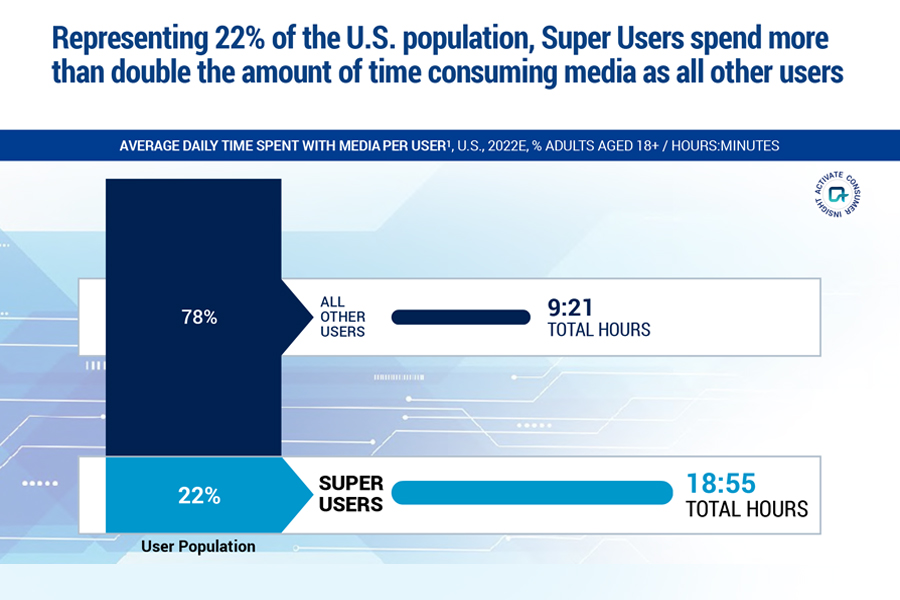
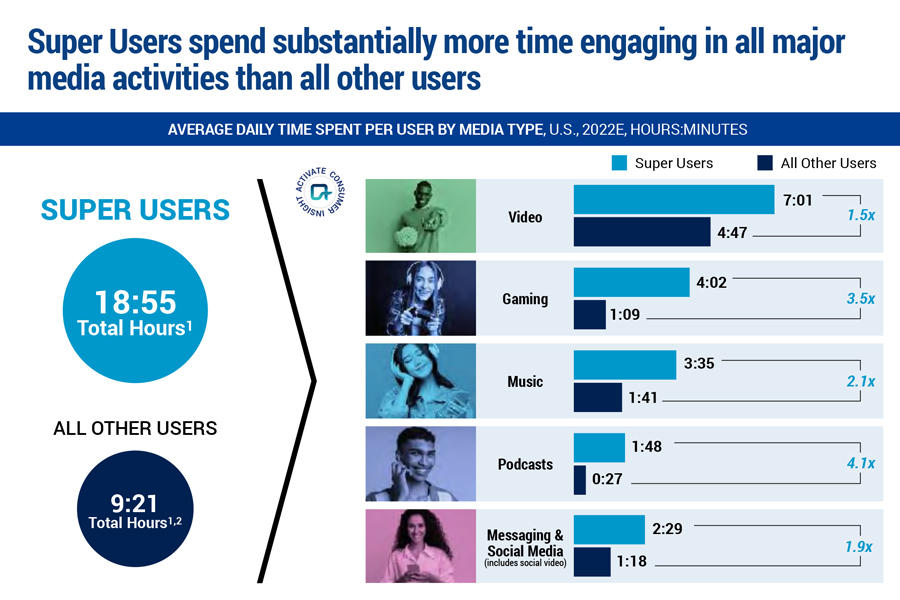
Inclined to multitask
Super Users take multitasking to the next level. Not only do they spend more time with electronics, but they excel in the art of juggling multiple activities. While watching videos and playing video games on one device, Super Users might also be busy engaging with social media on another. This makes them an unstoppable force when it comes to getting the most out of their digital experiences!

High share of dollar spend
Super Users are big spenders when it comes to media, particularly in gaming and music. Compared with all other users, Super Users’ average video spend is close to triple the amount ($76 vs $27). However, their biggest increases come from gaming and music; they’re collectively spending 12x more on games and shelling out 21x as much for tunes!
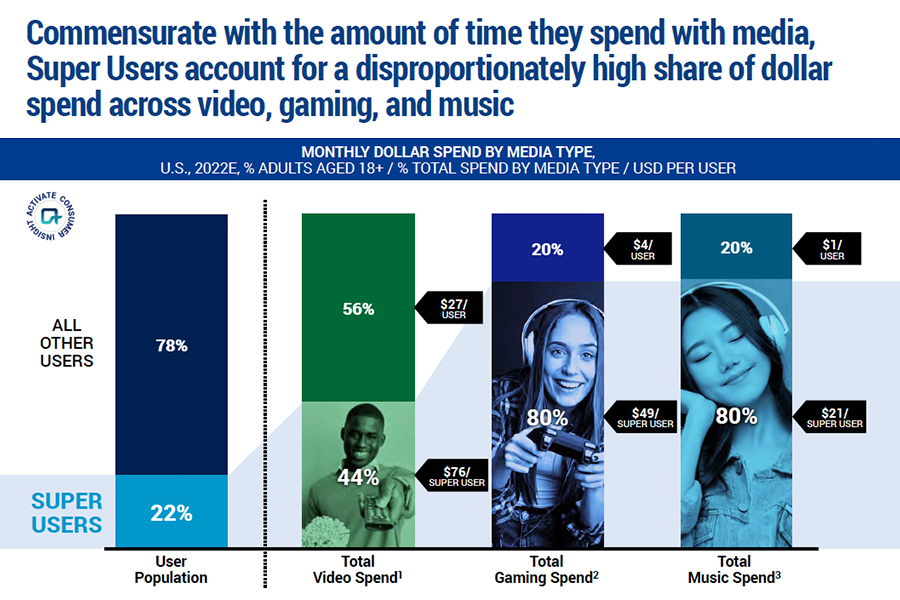
With 60% of eCommerce spend coming from Super Users, they are driving the industry forward with their enthusiasm and willingness to test out cutting-edge shopping trends like buying through social media, live streaming purchases, and trying on products virtually. Super Users are setting the tone for this dynamic industry.
Technology and media adoption
Most Super Users are brand advocates. They’re trendsetting individuals who stay ahead of the curve on media and technology. They eagerly take advantage of new products, services, and data-sharing opportunities to receive tailored ads that fit their lifestyle.
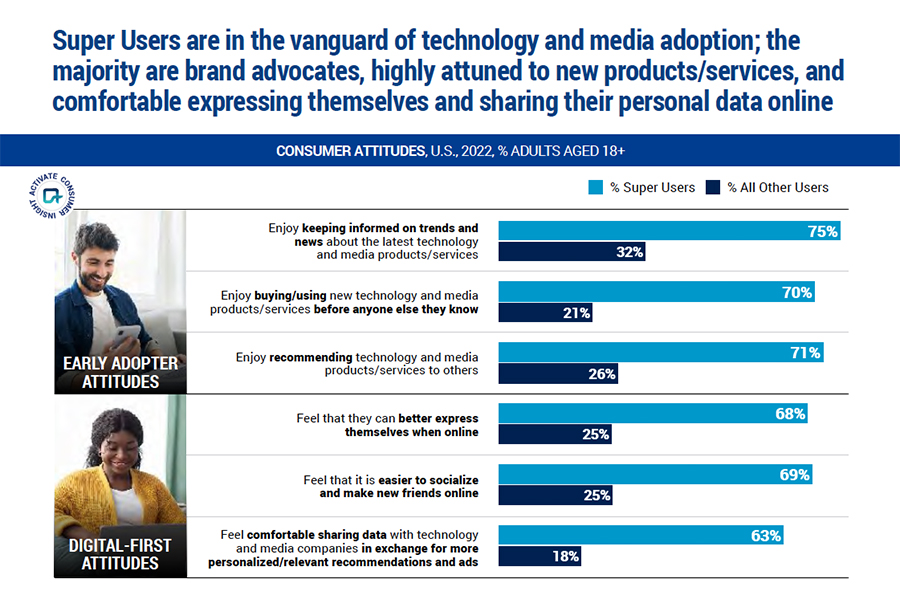
Crypto & NFTs
Super Users blaze the trail for cryptocurrency and non-fungible tokens (NFTs)! This group is five times more likely to explore, engage with, and embrace new digital-monetary technologies.
Pioneers of the Metaverse
As Metaverse usage continues to rise, Super Users are leading the way. Over 80% of these trailblazers have embraced these digital spaces within just the last year. We’re seeing accelerated interest from them as they seek out new opportunities for creativity, connections, and transactions within their favorite Metaverses. Many express interest in Metaverse experiences such as purchasing physical items to creating virtual havens. In fact, they’re 5x more interested in all things meta-related!
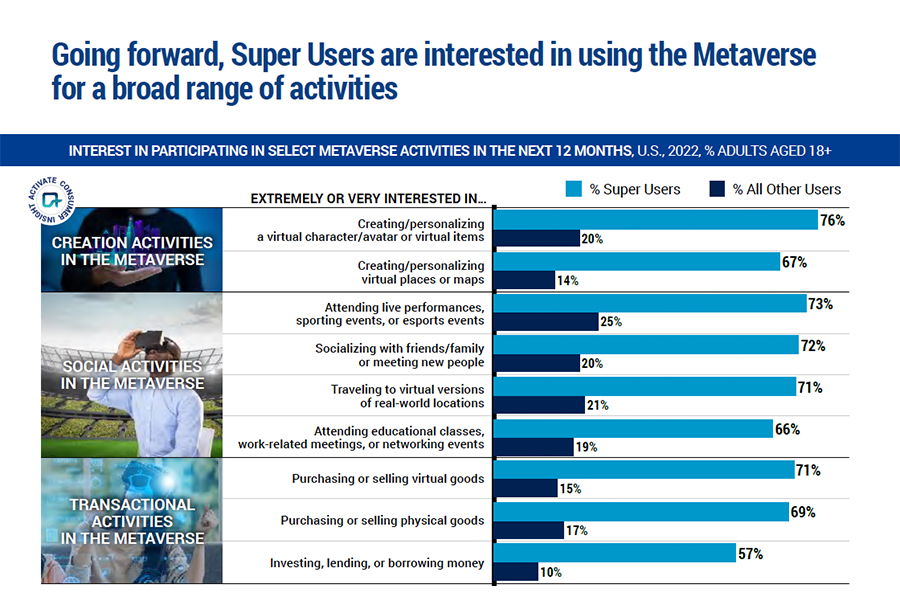
How Experian can help you identify and target Super Users
So how can you find your Super Users and include them in your marketing targeting strategy? Whether you want to build or acquire highly addressable audiences, we can help you precisely reach the right individuals and households in any channel you desire with Consumer View.
Consumer View
It all starts with data. Delivering the right message in the right place at the right time means truly knowing your prospects and customers as individuals – their lifestyles, behaviors, and shopping preferences. Consumer View data can provide a deeper understanding of your customers.
Consumer View is the world’s largest consumer database that contains over 3,900 attributes for 250 million adult consumers in the U.S. with coverage of 126 million (98%) of U.S. households. Consumer View can help you find out:
- What do your customers look like?
- What do your customers do?
- How and when should you reach your customers?
- What motivates your customers?
Modeled and syndicated audiences
We have over 2,500 pre-built audiences that are privacy-safe and built using advanced data science and the most comprehensive consumer data available. These digital audiences are readily available via major publishers, data management platforms (DMPs), advanced TV operators, and demand-side platforms (DSPs).
Our pre-built audiences can be used consistently across multiple distribution partners – making sure you can quickly find the right audience for the right campaign without having to build your own consumer personas. In addition to being available as digital audiences, our segmentation products are also available to use across all consumer touchpoints to enable consistent omnichannel campaign targeting.
There are infinite data combinations and selections we can help you with for optimal audience targeting. Using our comprehensive inventory of data, we can find even the most unusual of audiences to help you connect with new prospects. From demographics to behavioral and psychographic information, we draw on a massive base of knowledge accumulated during five decades in business.
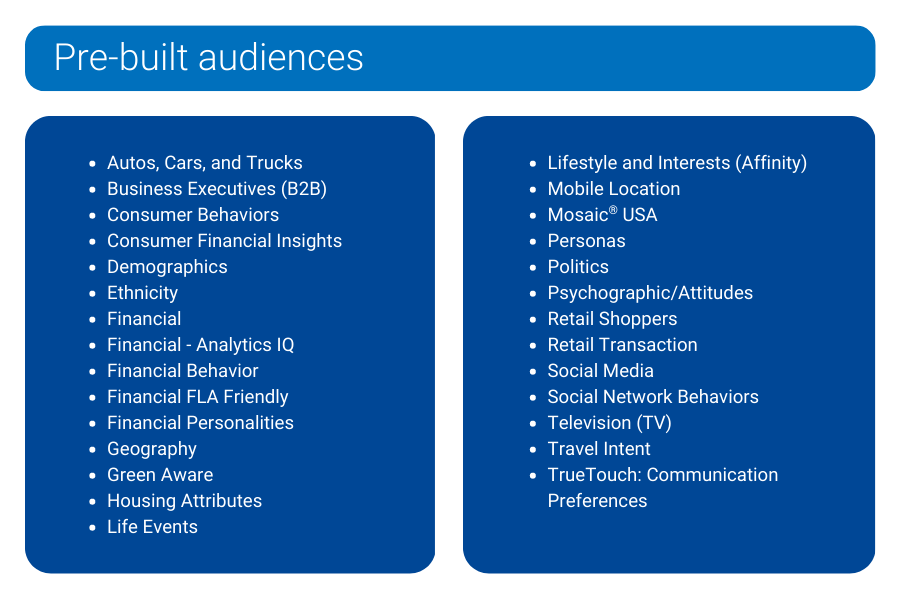
Mosaic® USA
Experian’s Mosaic® USA is a household-based consumer lifestyle segmentation system that classifies all U.S. households and neighborhoods into 71 unique types and 19 overarching groups, providing a 360-degree view of consumers’ choices, preferences, and habits. Using Mosaic lifestyle segmentation, you can anticipate the behavior, attitudes, and preferences of your best customers and reach them in the most effective traditional and digital channels with the right message in the right place at the right time.
Tailored Segmentation uses a sophisticated data-driven clustering system that leverages the 71 Mosaic types that match to first-party data like yours. Tailored Segmentation allows you to regroup Mosaic types based on the attributes you weigh as more impactful to your business. Have you designed your own segments in-house? You can apply Tailored Segmentation to those segments for deeper insights through a tailored analysis. Are you still looking for a way to segment your market even though you understand your typical best customer? Tailored Segmentation can weigh these attributes and develop a custom clustering and analysis of your market.
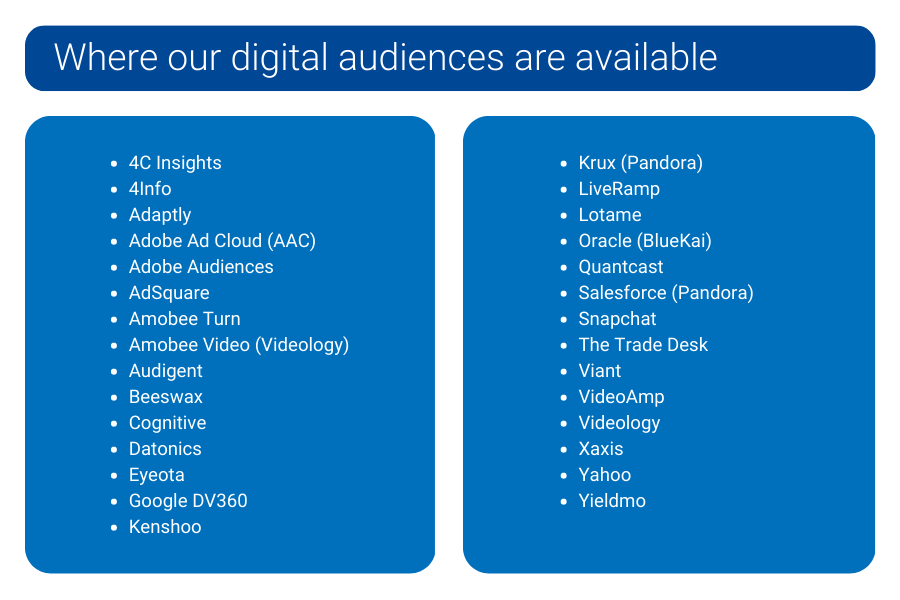
We can help you find your Super Users
Super Users are an important segment of any market. Marketers need to be able to identify them quickly and act upon their insights. Our marketing solutions provide the necessary data and analytical capabilities to easily find and target your potential Super Users for an effective marketing targeting strategy.
With Experian, you can deliver messages that are more in line with what matters to this influential group of customers. We understand how challenging it can be to find these customers and ensure they get the tailored, personalized messaging they deserve – so let us help you do just that! We can provide deep insights beyond the generic customer persona that allows marketers to look into the effectiveness of their marketing strategies from multiple angles. We want to help you gain an edge over your competitors by helping you identify, target, and engage Super Users for increased revenue growth. Ready to find your Super Users?
Sources
Activate Technology & Media Outlook 2023. Activate Consulting.
Latest posts

School may be out for the summer, but this is the perfect time for marketers to begin back-to-school planning. Follow these five simple tips and be on your way to back-to-school success. Searchers are actively seeking out ideas around clothes, hairstyles and dorm room décor as they prepare for the school year to start. Leverage sites like Pinterest to promote back to school merchandise and content. Don’t forget to include DIY and customization options as these appeal to today’s students. Don’t underestimate the influence of moms and college students. These consumers are more likely to actively search for the best deals online so test using deal-seeking terms like “free” and “sales” in promotional campaigns. In 2013, Marketers experienced a 35 percent lift in unique clicks when they used the word ‘college’ in the subject line. This year, try targeting specific ages for back-to-school by including terms like “college” and kids” in the subject line. Timing of back-to-school campaigns matters. While August is the key month for back-to-school campaigns, there may be more opportunity to mail additional campaigns for school supplies in July, and clothing and accessories in early September. Don’t forget to personalize! Last year, we saw a 44 percent increase in unique open rates for emails that contained personalization in the subject line. These tactics should be included in a strong back-to-school mailing program. For more information on back-to-school planning, download the 5 Lessons for Back-to-school Marketers in 2014 report.

Experian Marketing Services conducted an analysis into the attitudes, language preferences, spending habits and media behaviors of Hispanic Consumers, some of which were featured in the 2014 Hispanic Market Overview presented by López Negrete Communications. This post highlights findings from that analysis, which focus on Hispanic consumers’ adoption and use of smartphones. Hispanic consumers, who today account for 15 percent of the total U.S. adult population and 22 percent of Millennials, represent an ideal audience for mobile engagement and mobile advertising. While cell phone ownership rates among Hispanic and non-Hispanic adults are equal, Hispanics are more likely to own a smartphone and use it as their primary device to connect to the Internet. According to the latest estimates from Experian Marketing Services, 63 percent of Hispanic adults own a smartphone versus 60 percent of non-Hispanics. That’s up from 52 percent and 51 percent, respectively, since 2012. Among smartphone owners, Hispanics are 17 percent more likely than non-Hispanics to say that they access the Internet more through their phone than through a computer. In fact, 45 percent of Hispanic smartphone owners are mobile-dominant when it comes to going online compared with 38 percent of non-Hispanics. Marketers courting the influential Hispanic consumer must consider this fact and take a mobile-first approach to ensure that online marketing efforts, including everything from email to websites to e-commerce, are designed to engage the customer as effectively on a mobile device as on a computer. Even traditional marketing tactics such as television ads should reflect the growing likelihood that Hispanics have a smartphone either nearby or physically in their hand and are ready to engage. In fact, 37 percent of all Hispanic adults say that they often use their cell phone while watching television compared with 29 percent of non-Hispanics. Among smartphone owners, the share of Hispanics who use their phone while watching television shoots up to 50 percent versus 42 percent of non-Hispanics. Millennial smartphone owners are among the most likely to be splitting their attention between the big and small screen with 61 percent of Hispanic Millennials and 58 percent of non-Hispanic Millennials doing so. Knowing what specific mobile activities Hispanics are engaging in is critical for marketers in identifying the best tactics for reaching them via mobile. The chart below shows that Hispanics engage in most smartphone activities at above average rates, but they are much more likely than non-Hispanics to IM/chat on their phone. As a result they are slightly less likely than non-Hispanics to email from their phone, though the vast majority of Hispanic smartphone owners still use mobile email. Other activities that marketers will find Hispanics engaging in at above average rates include watching videos, using mobile GPS and listening to music. Learn more about how Experian Marketing Services can help your organization more effectively target, reach and engage today’s Hispanic consumer.

Published in MediaPost With the explosion of smartphones and digital tablets and the steady rise of Internet-connected televisions, gaming consoles, and more, consumers are increasingly watching online video when and where they want. New research from Experian Marketing Services on cross-device video found that as of October 2013, 48% of all U.S. adults and 67% of those under the age of 35 watched online video during a typical week, up from 45% and 64%, respectively, just six months earlier. At the same time, the share of households considered “cord-cutters” — those with high speed Internet but no cable or satellite TV — is on the rise, and that has a real impact on marketers and on the medium of television, the recipient of the largest share of advertising dollars. While the growing trend in cord-cutting is understandably disturbing to cable and satellite companies and disruptive to the television advertising revenue model overall, the growth in online viewing creates opportunities for marketers. Online video viewers can be more easily targeted and served up advertising that is more relevant, responsive and measureable. Marketers can also be more confident that their online ad was actually seen given that viewers are typically unable to skip ads. And while CPMs for online video ads may generally be lower than those of TV, marketers can use that savings to negotiate costs based on clicks or transactions rather than impressions, giving them a better picture into audience interest and insights to inform their budget allocation. Expect “Cutting the cord” to continue Today, over 7.6 million U.S. homes or 6.5% of households are cord-cutters, up from 5.1 million in 2010 or 4.5% of households. One thing enabling consumers to cut the cord is the rise in Internet-connected TVs, which allows viewing of Internet video on demand without sacrificing screen size. In fact, a third of adults (34%) now have at least one TV in the home that is connected to the Internet either directly or through a separate device like an Apple TV or Roku, up from 25% in 2012. With the launch of devices like Google’s Chromecast and the Amazon Fire TV, those numbers are sure to rise even more in the months and years ahead. Cord-cutters like the bigger screen Our analysis found that the act of watching streaming or downloaded video on any device is connected to higher rates of cord-cutting but the act of watching on a television is the most highly correlated. In fact, adults who watch online video on a television are 3.2 times more likely than average to be cord-cutters. Those who watch video on their phone (the device identified in the analysis as that most commonly used for watching online video) are just 50% more likely to be cord-cutters. Millennials are more likely to be cord-cutters We found that households with an adult under the age of 35 are almost twice as likely to be cord-cutters. Throw a Netflix or Hulu account into the mix and the rate of cord-cutting among young adult households jumps to nearly one-in-four. Given these surprising stats, many Millennials may be cord-cutters without ever having “cut” a cord. And that’s an important trend to watch since it means a significant portion of this generation will never pay for TV. Millennials are also the most device-agnostic, with over a third saying they don’t mind watching video on a portable device even if it means a smaller screen. That’s more than double the rate of those ages 35 and older. This decentralized viewing can create headaches for marketers who need to start a relationship with Millennials during this stage of their lives when they’re most open to trying out new brands and have yet to settle down. On the plus side, marketers who do manage to reach this audience will find them much more open to advertising than average. In fact, Millennials are more than four times more likely to say that video ads that they view on their cell phone are useful. So while the challenge is big, so is the potential reward.